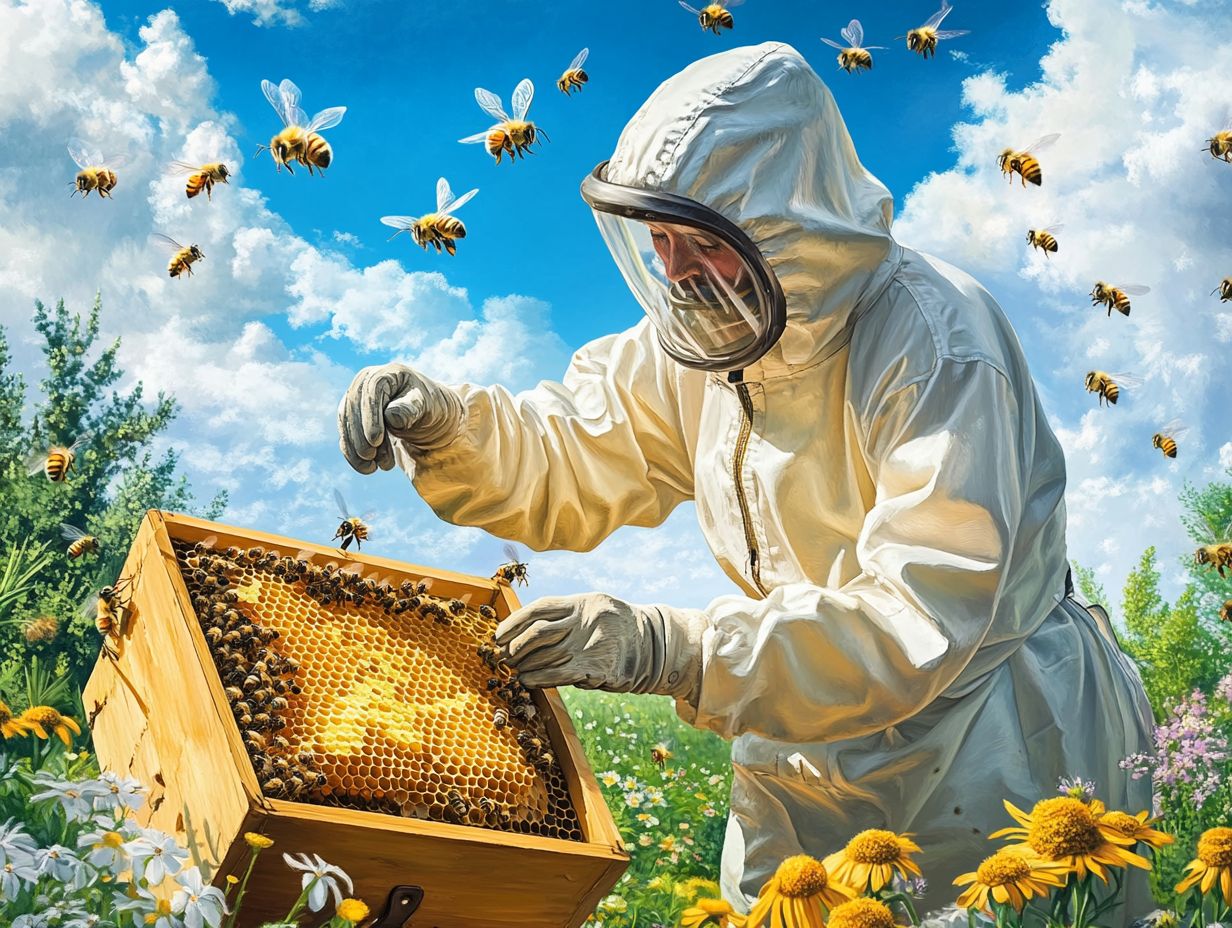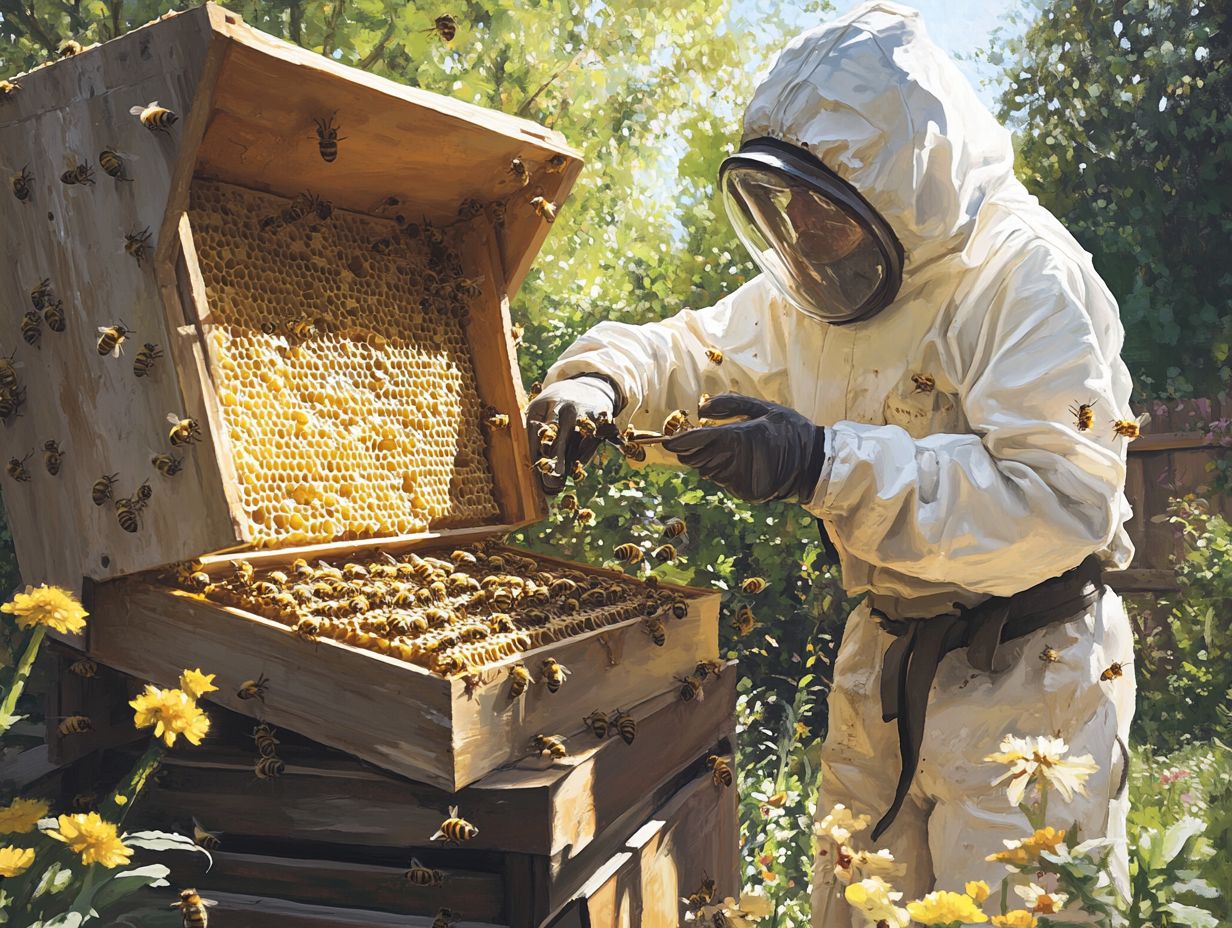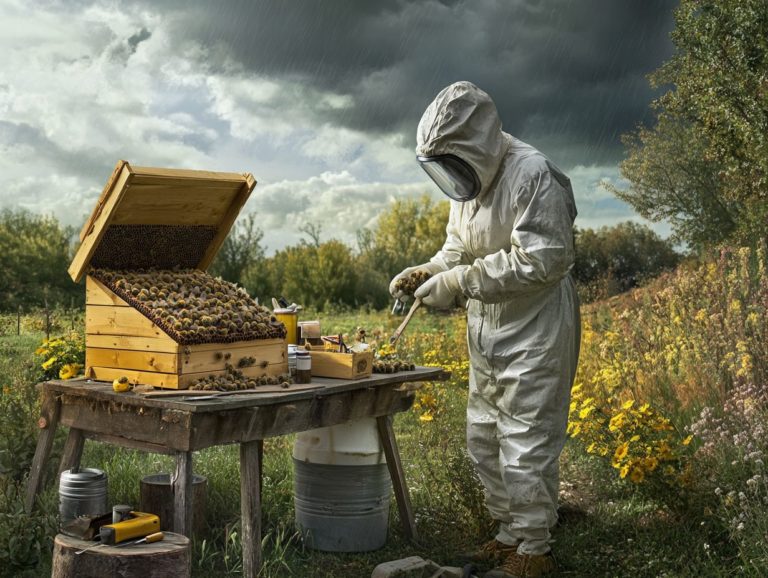Beekeeping Challenges: Hive Management Tips
Effective hive management is essential for maintaining healthy honey bee colonies and ensuring the success of your beekeeping operation.
This article delves into the fundamentals of hive management, emphasizing its importance and the common challenges you may encounter, such as pests, diseases, and queen failures. It offers practical tips to help you navigate these obstacles. These tips include conducting regular hive inspections and providing proper nutrition and hive maintenance.
Whether you re a seasoned beekeeper or just beginning your journey, this guide is designed to elevate your hive management skills and promote thriving bee populations.
Contents
- Key Takeaways:
- Understanding Hive Management and Seasonal Tasks
- Common Challenges in Hive Management
- Tips for Effective Hive Management
- Frequently Asked Questions
- What are some common challenges beekeepers face when managing their hives?
- How can I prevent pests and bee diseases from affecting my beehives?
- What is colony collapse disorder and how can I avoid it?
- What are some tips for managing beehives in harsh weather conditions, especially during winter tasks?
- How can I maintain a healthy balance of honey production and pollination in my beehives?
- What are some signs that my beehive may need more attention or intervention?
Key Takeaways:

- Regular hive inspections are crucial for effective hive management and early detection of potential issues such as pests, diseases, and queen failure. Proper inspection techniques can help mitigate these issues.
- Proper nutrition and supplementation, such as feeding sugar water and pollen patties, play a vital role in maintaining strong and healthy bee colonies, especially during times of limited forage availability or nectar dearth.
- Preventing and managing hive pests and bee diseases through proper monitoring, sanitation, and treatment is essential for successful hive management and overall honey bee health.
Understanding Hive Management and Seasonal Tasks
Grasping the intricacies of hive management is essential for every beekeeper, especially those just starting, as it plays a pivotal role in maintaining the health and productivity of their honey bee colonies.
Effective hive management demands all-around care that includes routine hive inspections and meticulous hive maintenance. Vigilant monitoring of colony health is also necessary, especially in tune with the rhythm of seasonal changes.
Esteemed beekeepers, such as Gene Scarborough, underscore the significance of employing proper husbandry methods. They also emphasize leveraging the educational resources offered by beekeeping clubs and beekeeping classes to cultivate a flourishing environment for honey bees.
What is Hive Management?
Hive management is your systematic approach to maintaining and optimizing the health and productivity of your honey bee colonies. This includes tasks like replacing old comb with new to maintain hive health and proper husbandry.
Hive management is crucial and includes key activities that keep your bees happy and healthy! These activities involve regular inspections, vigilant monitoring for pests and diseases, and ensuring that the environmental conditions within the hive are just right. Effective hive management requires specialized tools, such as hive tools for manipulation, beekeeping suits for safety, and various monitoring equipment to assess your colony’s health. Protective equipment is crucial for the beekeeper’s safety.
By employing techniques like proper feeding, swarm prevention, and maintaining optimal space within the hive, you can significantly enhance the vitality of your colonies. Ultimately, investing in high-quality beekeeping equipment and embracing these practices will pave the way for success in your beekeeping endeavors, resulting in healthier colonies and increased honey production. Maintaining a beekeeping journal can help track your progress and identify areas for improvement.
Why is Hive Management Important?
Effective hive management is essential, as it has a direct influence on the health of your colonies, honey production, and the critical role honey bees play as pollinators in our ecosystems. Beekeeping books can offer valuable insights and techniques.
Overlooking proper hive management practices risks inadvertently triggering colony collapse, leading to significant declines in bee populations. This not only diminishes honey yields, impacting your livelihood and the honey market, but also disrupts the vital pollination services that bees provide to agricultural crops and wild plants. Beekeepers must act as environmental stewards to protect these important pollinators.
Issues such as poor nutrition, inadequate pest control, and the absence of regular hive inspections can compound these problems, ultimately threatening the stability of the food systems that rely on these diligent pollinators. As your colonies struggle to survive, the consequences extend beyond your apiary, underscoring the importance of recognizing the intricate relationship between effective hive management and the sustainability of bee populations.
Don t wait start implementing these tips now to safeguard your bees and enhance your honey yields!
Start applying these hive management tips today to boost your beekeeping success and protect our precious pollinators!
Common Challenges in Hive Management
Common challenges in hive management can profoundly impact the health and productivity of your bee colonies. Taking preventive actions is key to your bees’ success! It s vital to tackle issues like pests, diseases, and the challenges posed by harsh seasonal conditions. Beekeeping management techniques can help mitigate these challenges.
By staying ahead of these potential threats, you can ensure that your colonies thrive and flourish.
1. Pests and Diseases

Pests and diseases present significant challenges to honey bee colonies. The varroa mite is one of the most infamous threats capable of causing problems for colony health. These minuscule, parasitic mites latch onto bees, resulting in weakened immune systems that leave the hive vulnerable to other ailments such as American Foulbrood and Nosema.
In addition, pests like wax moths and small hive beetles can inflict further damage by disrupting the hive’s structure and feasting on stored honey and beeswax.
To effectively combat these dangers, you must adopt preventive measures, including:
- Using proper feeding techniques
- Regularly inspecting your hives
- Maintaining strong and healthy colonies
- Doing regular comb rotation
- Implementing integrated pest management strategies (a combination of techniques to control pests effectively)
Using effective treatments, such as organic acids and mite-resistant bee strains, can also play a crucial role in safeguarding these vital pollinators. Your vigilance and proactive care are essential for ensuring the long-term health of honey bee populations and the success of your beekeeping efforts. Participating in educational opportunities and joining a beekeeping association provides support and resources for effective hive management.
2. Queen Failure
Queen failure can create significant upheaval in hive management. A healthy queen is crucial for sustaining the colony s structure and productivity. The queen honey bee’s pheromones are key to maintaining harmony within the hive.
Without a functional queen, you ll notice the dynamics of the hive shifting rapidly. This leads to reduced brood production and a breakdown in effective communication among the worker bees. This disruption hampers reproduction and jeopardizes the overall health of the hive, making it more vulnerable to pests and diseases.
In the absence of a queen, worker bees often scramble to create a new one, a process that consumes time and resources, leaving the colony exposed during this precarious transition. Mistakes like failing to recognize the signs of queen failure can exacerbate these issues.
If you want to keep your colonies strong and thriving, understanding queen issues is crucial!
3. Swarming
Swarming is a natural behavior of honey bees that, while essential for reproduction, can indeed be a challenge for you as a beekeeper when it leads to a decrease in hive population and honey production. Honey bee swarming is often triggered by overcrowding in the hive.
This phenomenon typically unfolds in the spring or early summer, a time when your hive is bustling and conditions are ripe for expansion. During this period, factors like overcrowding, limited resources, and the presence of queen cells can trigger this instinctive response among the bees. Additionally, bees washboarding a behavior where bees move in a rhythmic pattern across the comb, indicating stress or overcrowding can signal impending swarming.
As a beekeeper, your role is pivotal in managing the hive conditions to curb swarming. Regular inspections are your best ally, helping you spot early signs and enabling timely interventions, such as splitting hives or adding extra space with supers. By nurturing a balanced environment, you can not only maintain the health of your colonies but also optimize honey yields, ensuring that both your bees and your beekeeping efforts flourish.
4. Lack of Forage
A lack of forage, especially during tough nectar droughts, can seriously impede your colony’s ability to thrive and produce honey. This underscores the critical need for effective management of foraging resources.
Feeding honey bees with supplemental sugar water during these times can help alleviate the scarcity. When forage availability dwindles, the health of your bee populations can take a hit, resulting in weakened colonies that struggle to maintain their productivity.
To tackle this challenge, you can adopt several strategies to enhance foraging opportunities. One effective approach is to plant native plants that naturally thrive in your local ecosystem, offering your bees a steady and diverse supply of nectar and pollen.
Backyard beekeeping can greatly benefit from such sustainable practices. By incorporating flowering plants throughout the growing season, you ensure a continuous food source, which is vital for maintaining hive health.
You might also consider creating designated wildflower areas or participating in community initiatives to promote local flora. This not only fosters a flourishing environment for pollinators but also elevates your overall hive management practices.
Tips for Effective Hive Management
Effective hive management encompasses a collection of best practices designed to significantly boost the health and productivity of honey bee colonies. By conducting regular hive inspections and ensuring proper nutrition, you can create an environment where your bees thrive and flourish.
1. Regular Hive Inspections

Regular hive inspections are essential for effective hive management, allowing you to monitor the health of your colonies and catch any potential issues before they escalate.
Aim to inspect your hives every 7 to 14 days to keep your bees happy and healthy! This frequency ensures you can intervene promptly if any problems arise.
During each inspection, take the time to closely examine the brood pattern, confirm the presence of the queen, and check for any signs of pests or diseases, such as Varroa mites. Varroa mites are small parasites that can harm bee colonies, so it’s crucial to monitor for them.
It’s also vital to evaluate the food stores to ensure your bees have sufficient resources to thrive. Embracing this proactive approach creates a thriving environment that supports the overall colony health and health of your honey bees, ultimately leading to improved honey production and the longevity of your hives.
Being part of beekeeping clubs and attending beekeeping classes can also provide valuable insights into hive management.
2. Proper Nutrition and Supplementation
Proper nutrition and supplementation are absolutely essential for maintaining healthy honey bee colonies, particularly during periods when forage is hard to come by, such as during a nectar dearth.
Don t wait for your bees to suffer; turn to sugar water immediately when natural food sources dwindle! It’s common for beekeepers to turn to sugar water and pollen patties as effective nutritional supplements.
These approaches not only sustain the bees but also boost their vitality and productivity. Sugar water acts as a quick energy source, keeping your bees energized during tough times.
Meanwhile, pollen patties deliver the essential proteins and lipids necessary for healthy brood development and active foraging. These are essential seasonal hive management practices that ensure the well-being of your colonies.
By incorporating these supplementation strategies into your hive management, you foster resilience and ensure robust bee populations, all while supporting sustainable beekeeping practices. Remember to also document your feeding honey bees practices in a beekeeping journal for future reference.
3. Pest and Disease Prevention
Implementing effective pest and disease prevention strategies is crucial for sustainable hive management. This is especially important for new beekeepers learning to navigate hive pests and bee diseases.
By regularly monitoring your hive environment and adhering to good beekeeping practices, you can significantly diminish the risks associated with common threats like varroa mites, American foulbrood, and chalkbrood. Incorporating methods such as removing male bee brood to manage mite populations, utilizing beneficial microorganisms, applying organic treatments, and using proper protective equipment will help you tackle these challenges head-on.
Routine inspections are vital. By identifying early signs of infestations or disease, you can ensure that awareness and timely intervention keep your colonies thriving.
Fostering genetic diversity within your hives enhances their resilience, making prevention a key component of your successful beekeeping journey. Join your local beekeeping association today to learn more and connect with fellow beekeepers!
4. Requeening
Requeening is a vital element of hive management that involves replacing an aging or underperforming queen honey bee to uphold the vitality and productivity of your colony. This process is essential to keep your hive thriving and buzzing with activity! It is crucial not just for maintaining reproductive capacity, but also for ensuring the overall health of the hive. It can also prevent the formation of aggressive honey bee colonies and ensure a steady population of worker bees.
As time passes, you may notice that your queen begins to struggle with consistent egg-laying, which can result in a decline in worker numbers and a subsequent drop in honey production. To effectively introduce a new queen, it s important to consider the timing and techniques that minimize stress on the colony. Utilizing a queen cage can facilitate a gradual acceptance, allowing the colony to adapt smoothly. This is an integral part of proper husbandry and seasonal tasks that contribute to successful beekeeping.
By carefully managing queen dynamics and performance, you can significantly enhance the resilience of your colony. This proactive approach promotes stronger foraging activities, ultimately leading to improved honey yields and healthier bees. Don’t forget to record these activities in your beekeeping journal to track progress and make informed decisions in the future.
Frequently Asked Questions
Gene Scarborough, a notable beekeeper from Santee Cooper Resort in South Carolina, offers insights into these common queries.
What are some common challenges beekeepers face when managing their hives?

Some common challenges beekeepers face include pests and diseases, colony collapse disorder, harsh weather conditions, and maintaining a healthy balance of honey production and pollination. Access to beekeeping equipment and proper hive maintenance can help mitigate these issues. Engaging in educational opportunities such as beekeeping books and beekeeping classes can also provide invaluable guidance.
How can I prevent pests and bee diseases from affecting my beehives?
Regular hive inspections, proper sanitation, and the use of natural pest control methods can help prevent pests and diseases from taking over your beehives. It’s also important to ensure that your bees have a balanced and healthy diet to boost their immune system. Consider utilizing native plants around your apiary to provide a consistent source of nectar and pollen.
What is colony collapse disorder and how can I avoid it?
Colony collapse disorder (CCD) is when bee colonies suddenly die. To avoid it, keep your bees healthy with diverse food sources and minimal stress.
What are some tips for managing beehives in harsh weather conditions, especially during winter tasks?
In extreme heat, ensure your bees have proper ventilation and a nearby water source.
In cold weather, insulate the hive and provide extra food to keep the bees warm.
Review beekeeping books to gain valuable insights for managing hives in different climates. Consulting experienced beekeepers can also offer helpful advice.
How can I maintain a healthy balance of honey production and pollination in my beehives?
To achieve a good balance, provide your bees with a variety of flowers and plants.
Ensure there s enough space for both new bees and honey storage.
Keep an eye on the hive’s population to avoid overworking them.
Changing the position of honeycomb frames and removing extra honey boxes at the right times can help keep the hive balanced.
What are some signs that my beehive may need more attention or intervention?
Watch for signs that your beehive needs extra care, such as a drop in honey production or bee population.
The presence of pests or diseases is also a cause for concern.
Regular hive inspections can help catch these issues early.
Look for behaviors like bees moving in a rhythmic pattern or unusual honey bee swarming, as these could indicate problems needing immediate attention.






